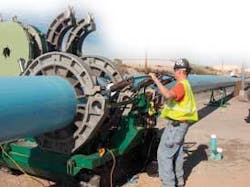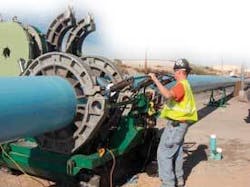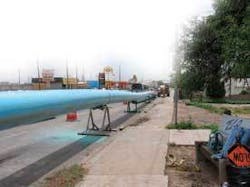When it comes to trenchless pipe installations, utilities now have two plastic pipe options: high-density polyethylene and fusible polyvinyl chloride.
HDPE, which originated in the oil and gas industry, proliferated in the water and wastewater treatment industry in the past decade “because you can do things like tunneling pipe underneath streams and other surface features, or with trenchless applications where gasketed pipe can’t compete because it’s not designed to hold up to such stresses and strains,” said Bo Botteicher, a former design engineer for Brown and Caldwell. “HDPE was a nice crossover with very desirable properties - a gasketless joint system, fully restrained.”
Today, Fusible PVCTM also meets those requirements, said Botteicher, who now works at Underground Solutions Inc. (UGSI). The trademarked product from UGSI features a proprietary PVC formulation that, when combined with the company’s patented fusion process, results in a monolithic, fully restrained, leak-free piping system.
“We’re using it (Fused PVC) a lot in the water industry, and we’re just getting to where we’re using it for new installations in the gravity sewers,” said Tom Simone, an engineer III from Lafayette (La.) Utilities System. “We’ve used them on road bores, with LA DOT’s blessing. We also spec them out - not only in-house jobs, but also on jobs in which developers are installing a system and send us the plans for approval.”
The primary difference between the two pipe materials is the strength of the plastic, Botteicher said. HDPE has about half the tensile strength of PVC and can stretch on longer pulls. The PVC pipe also has stronger walls and is less likely to sag.
The new PVC product was used recently on a project in El Paso, TX. The project involved sliplining about three miles of 36 inch steel lined concrete cylinder pipe that had failed numerous times in recent years.
“We had learned through talking to the representatives on both sides that PVC is a more rigid pipe, so when they’re pulling it, it tends not to elongate as much as an HDPE pipe would. So, it would relax quicker and we wouldn’t have to wait as long to work on the pipe once you’ve pulled it through,” said Tom Cieslik, a project engineering manager at El Paso Water Utilities.
“The fusing time was also quicker because the PVC was thinner, so the heat load wasn’t as bad,” he said.
Because PVC is stronger, the project team could dig fewer pits and pull the pipe farther underground, said Botteicher, who helped design the El Paso project while at Brown and Caldwell.
Standard Sizing
HDPE is sized according to the convention for industrial pipes, Botteicher said. PVC, on the other hand, was designed for the water and wastewater treatment industry so is sized according to the convention for ductile iron pipes.
“It just made sense to have PVC meet the same dimensional sizing and the same pressure-holding capabilities of the pipe and the fittings that it was going to be used with,” he said.
Because of the standard sizes, specialized transition couplings are not needed with the PVC pipe.
Simone added. “Wherever you are on the bore,” he said, “if you decide you need to do something different, you can use conventional methods - cut into it, bore into it, tap into it, whatever you need to do - whereas with HDPE, you have to basically fuse any and everything. The PVC fittings are C900, and you slap them on.”
“It can be connected and restrained just like ductile iron pipe,” Botteicher said, and “ductile iron pipe fittings are the ones that are always used on these jobs, because they’re the least expensive - and the ones that the city already has in stock and knows how to use.”
PVC was selected for the El Paso project in part because of a requirement that the pipe handle a standard pressure of 150-165 psi. The pipe came in with a lower bid because HDPE pipe had to be thicker to meet the pressure requirement, driving up costs, Cieslik said.
Also, because HDPE pipes aren’t available in the same sizes as other water pipes, “the cost difference in hardware - couplings, fittings and valves especially - would be very significant,” Botteicher said.
On average, the city of Lafayette found that “there’s not a significant price difference between the PVC and HDPE pipe themselves, Simone said, but PVC installation costs are lower because “you’re not having to use the Harvey adapters” when connecting the plastic pipe to iron or concrete pipe.
There was initial concern in El Paso that PVC’s rigidity would be a problem pulling through minor deflections in the 36 inch host pipe. The project called for a liner pipe with an inner diameter of at least 24 inches. However, the PVC pipe selected for the project had an outside diameter of only 26 inches, leaving room to make the turns.
On the first and second pulls for the project, the contractor pulled through a 20-foot unfused section of pipe to make sure it wouldn’t get hung up, Cieslik said.
“Once they got through the second run, though, they did the straight pull right from the start. They haven’t had to do a test pull since and haven’t had any problems,” he said.
Installation has been fast and essentially painless, Cieslik said.
“Underground Solutions comes in and fuses a pipe for a particular pull,” he said. “They may be able to fuse the pipe in a couple of days, while Horseshoe [the contractor] is out there digging the pits and getting things ready. Then within a week, that pipe’s in the ground - and those are 1500-foot stretches - and they’re ready to move on to the next area.”






